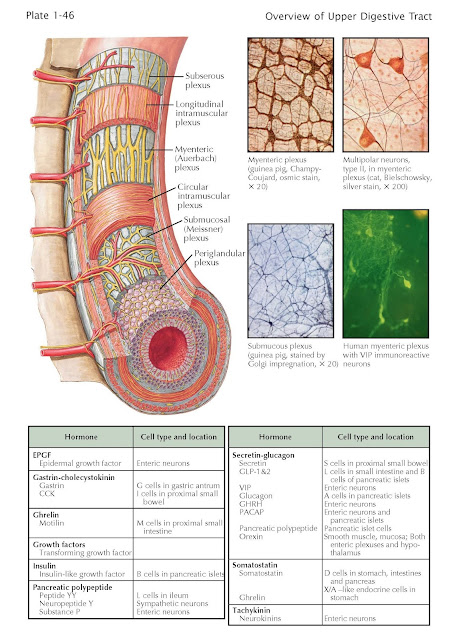Enteric Nervous System
The digestive system’s enteric nervous system is
by far the largest neural network outside of the CNS and contains more neurons
than the spinal column. The variety of neurotransmitters is similar to that in
the CNS. The complexity with which these transmitters interact is fascinating
and intricate. This system provides the local “hard wiring” for all local gut
reflexes, most notably peristalsis. Local responses are modulated by input from
the other regulatory systems (extrinsic hormones, intrinsic hormones,
parasympathetic and sympathetic nerves from the autonomic nervous system, and
other enteric nerves).
The bodies of neurons in the enteric nervous system are located in two
layers in the gut, the Auerbach submucosal plexus and the Meissner
myenteric plexus. The Auerbach plexus is located on the luminal side of the
circular muscle and has sensory neurons, effector neurons, and interneurons.
The simplest description of its function is that its neurons serve primarily to
integrate events and conditions in the lumen with the motility functions of the
muscularis mucosa and the secretory and vascular functions of the submucosa. It
is important to add, however, that reflexes have been identified from the
submucosal nerves to the myenteric nerves that mediate peristalsis as well as
to sensory sites in the dorsal root ganglia and mesenteric ganglia. For
example, light mucosal stimulation alters the peristaltic reflex via enteric
nerves in the mucosa to the submucosal ganglia and to extramural ganglia in the
mesentery and paraspinal ganglia.
It is similarly reasonable to view the myenteric plexus as having the
primary function of integrating all local reflexes, including local
contractions and peristalsis, as well as the blood flow needed to perform these
functions. For example, although most motor neurons are very short,
interneurons containing serotonin travel several centimeters to integrate the
peristaltic reflex.
The neurotransmitters in the two intrinsic plexuses are incredible in
number and complexity. Enteric neurons are characterized by their morphology
and neurotransmitter content. Over 30 neuropeptides have been identified and
sequenced. These transmitters are grouped in families based on similarities in
amino acid sequences. Although an encyclopedic summary is inappropriate for
this chapter, a brief listing of well-defined neurotransmitter families found
in the enteric nervous system of the digestive system is shown. Regrettably,
the names initially assigned to these transmitters often had little to do with
the primary functions that they were later found to perform. Furthermore, the
list of functions that are influenced by each transmitter belies any effort at
simplification. An anatomic factor that prevents an oversimplification of the
role of these transmitters is the demonstration that a single neuron may
contain more than one neurotransmitter. Colocalization of neurotransmitters
occurs across different classes of transmitters, including peptidergic and
nonpeptide transmitters, most notably nitric oxide. The incredibly complex,
specific influence these nerves have on functions has been further demonstrated
by the fact that in response to various stimuli, there may be selective release
of colocalized transmitters from a single neuron. Characterization of
transmitters as having specific functions risks oversimplification because the
transmitters may have different effects depending on the cell of origin. Some
common patterns have been noted, however. The tachykinin-neurokinin family of
peptides, especially NK-1 (substance P and substance K), are often shown to be
stimulating motor neurons. In contrast, vasoactive intestinal peptide is
invariably an inhibitory motor neuron, often colocalized with nitric oxide.
Somatostatin also inhibits many gastrointestinal functions, including
absorption, secretion, and blood flow. Neuropeptide Y is found throughout the
digestive tract colocalized with sympathetic transmitters such as
norepinephrine. Gastrin-releasing peptide not only stimulates the release of
gastrin, but within the enteric nervous
system it can function as a transmitter in interneurons. Calcitonin generelated
peptide is most commonly seen as a transmitter in afferent neurons, especially
those seen to reach the esophageal or intestinal lumen.
The role of the enteric nervous system, with its highly diverse neurons
and complex array of interacting neurotransmitters, emphasizes how incredibly
fine-tuned and integrated are the local reflexes of gut motility, secretion,
absorption, and circulation.





